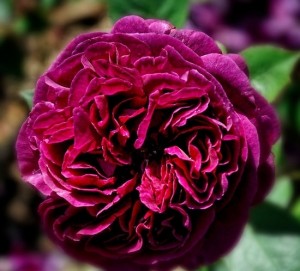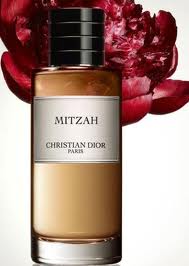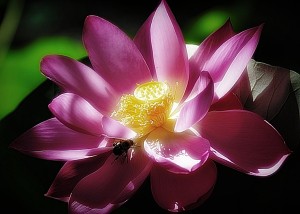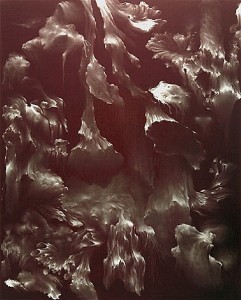Anubis rose from the darkness to survey his kingdom. The Underworld was a vortex of blackness from the incense in the air and the monstrous lava waterfall that cascaded a torrent of sticky, smoking, balsamic resins into the thick, turgid brown rivers of musky, leathered castoreum below. Anubis, God of the Dead, was himself made of these same things: his black body was smoking leather, tobacco’d resins, and incense turned as hard as obsidian, then covered with the musky, animalic sharpness of castoreum oil.

Anubis. Source: statueforum.com
Yet, there was also colour in this dark kingdom of spirits, subtle though it may be at times. The river banks were made from darkened cloves, then covered with pink lotus blossoms that smelled like dark green oakmoss. The path to Anubis’ throne was strewn with blood-red rose petals and sweet white jasmine, though the incense had rendered them dry and darkened. Creeping decay tinged their edges brown, as did the earthiness of pink lotus blossom absolute. Tiny flickers of yellow and orange came from fireflies made of citrus, which darted in the air by Anubis’ throne where Bast lounged almost naked.

Bast, Egyptian goddess. Painting by Eden Celeste. Source: edenceleste.com and fantasticportfolios.co
Bast (or Bastet) was originally a warrior deity who became the goddess ofsensual pleasures, of protection, and of cats. Legend had it that “a lioness, fiery and wrathful, was once cooled down by the water of the lake, transformed into a gentle cat, and settled in the temple.” It was a lie. In our tale today, it was she who did the taming, transforming Anubis by melting her musky, animalic, feline body into his leathered obsidian sharpness, bathing him in warmth, and then covering their intertwined, united self with labdanum amber lightly coated with a sliver of caramel sweetness. She softened his smoky fury, silenced his roar with a jasmine kiss on his cold, leathered mouth, dusted his body with cloves, then licked them off with a smile. By the power of amber and jasmine’s feminine sensuality, she tamed the masculine, blackened underworld of leather, fire and brimstone smoke– and Anubis was reborn.

Source: Papillon Perfumery.
My tale may be poetic license that changes ancient Egyptian mythology, but it is the best way I can describe a new fragrance calledAnubis by Papillon Perfumery. My first, immediate reaction to the scent was, “Wow!” That was followed shortly thereafter by “Oh my God,” some further sniffs of amazement, then a few awed phrases too vulgar to print here, lots of mental exclamation marks, and the sudden determination that every lover of dark, masculine, leathery, opulent, densely chewy, slightly naughty, luxuriously rich, smoky orientals had to try this amazing perfume. I rarely plead with people, but for a narrow segment of the perfume market with tastes like that outlined above — especially men or those who love fragrances likeAmouage‘s sadly discontinued, cult-hit, Tribute attar, SHL 777‘s Black Gemstone,Dior’s Mitzah, or Roja Dove‘s Nuwa — I am going to beg at the end of this review: you really have to sniff this fragrance. There isn’t a doubt in my mind that Anubis will be on my year-end list of the best releases of 2014.

Liz Moores of Papillon Perfumery. Source: Fragrantica.
Papillon Perfumery is a fledging British artisanal brand founded in 2014 by Liz Moores. Ms. Moores is a self-taught perfumer whose first creation was Anubis, a scent that she originally made for herself and which took four years to perfect. Apparently, whenever she wore it, people would come up to her to ask for the name of her perfume. (I believe it, because I certainly would have!) So, she eventually gave out a few samples to friends, and things slowly progressed from there.
In June 2014, Papillon Perfumery (sometimes called Papillon Artisan Perfumery, but hereinafter referred to just as “Papillon“) officially debuted with three fragrances: Anubis, Tobacco Rose, and Angélique. All of them are eau de parfums in concentration, and were initially limited to the U.K., but are now available in America at Indigo Perfumery. I purchased samples of all three, and will be reviewing each one in turn.

Liz Moores with “Perry.” Source: Papillon Perfumery.
Fragrantica and Indigo Perfumery both have wonderfully detailed interviews with Ms. Moores that provide insights into the character of her fragrances, the process by which she makes and develops a scent, and how she began a perfume business from scratch. I found the personal details in the much longer Fragrantica interview especially revealing about the overall Papillon style of perfumery. For example, Ms. Moore told Fragrantica that she loved opulent orientals, old-school fragrances, ’80s powerhouses, and rich Middle Eastern scents. To give you an idea of the style to which she is drawn, Amouage’s Homage Attar is one of her favorite fragrances, but she has also worn Fracas, Shalimar, and several creations from Frederic Malle. As a whole, my general impression from that piece is that Ms. Moores seems a truly sweet, warm, humble, genuine person who works incredibly hard on every aspect of the business, from creation to bottling, and has a genuine passion for both French Haute Parfumerie and Middle Eastern scents. (She’s also mad about animals, and rescues every manner of creature from horses to cats and wildlife — something which this animal lover respects and admires far more than anything involving perfumes.)

Anubis, God of the Dead, Embalming, and After-Life. . Wall relief from a tomb painting in the Temple of Abydos, Egypt, Dynasty XIX, 1317 B.C. Source: talariaenterprises.com
Ms. Moores spoke to Fragrantica about the inspiration for Anubis, its olfactory bouquet, and its name. As some of you may know, “Anubis” was the jackal-headed Egyptian god of mummification and the after-life, though he initially started out as the God of the Dead. The perfume, however, does not entail such morbid considerations. Ms. Moores explained that re-birth and re-incarnation were as just as important:
This was the first perfume I made and took me the best part of two years to get right. The first time around Anubis went massively over the safety limits of jasmine absolute so I had to completely rewrite the formula. It is called Anubis as there were so many cross references with the mummification materials used in ancient Egypt and because the perfume had to go through so many reincarnations until I felt it was right.[…]
I have always felt that the perfumes themselves are the personalities and the people who wear them forge the relationship with them. Anubis I always see as a man, and I refer to Anubis as “he.” I wanted to create a perfume with a dark heart as I find myself naturally drawn to perfumes that contain these elements. Leather had to feature, but I wanted it to smoke, almost like incense but with heady glimpses of jasmine woven throughout. I wanted it to have texture as this is really important for me in a perfume and sandalwood was the material that achieved this. None of my perfumes start with a name, the name always comes later as I find this easier to let the perfume come into existence almost by itself, without carving it to fit a mold.
Fragrantica‘s entry page for Anubis has a note list, but it is missing quite a few ingredients. Indigo Perfumery has the complete perfume pyramid:
Top notes: Egyptian Jasmine, Bitter Orange, Rose Otto, Pink Lotus
Heart notes: Immortelle, Rich Suede, Saffron, Clove Bud, Castoreum
Base notes: Frankincense, Sandalwood, Labdanum, Benzoin.

A page from the famous Book of the Dead, showing Anubis, second left. Source: fantasticportfolios.com
I’ve explained a lot about Anubis’ bouquet, character, and development in my introductory story, so this review will be different than most. I won’t break down the perfume in massive detail, though I will discuss how the perfume opens and develops for the opening few hours. The main reason for the change is that Anubis is what I call a very prismatic scent. Its primary, core essence of castoreum-drenched leather infused with animalic muskiness, blackened resins, and smokiness is always the same on my skin, a structural backbone that holds the perfume upright and the blood which runs through its veins from start to finish. That never changes, although, as you will see, its secondary notes and their prominence seem to vary not just from wearing to wearing, but sometimes even from one minute to the next.

Crimson Rose by Karen Betts. Source: redbubble.com
Anubis opens on my skin with smoke, dark labdanum amber, and a beefy, meaty, incredibly rich, blood-red rose. The latter is dusted with cloves and saffron that is fiery red, but also a little bit buttery. The rose bleeds miniscule droplets of crimson bitter orange, and is backed by a sense of a dark, mossy greenness. The primary bouquet is a fiery red-black above a sliver of something leathery in the base which is coated by the thinnest layer of amber. It has a caramel nuance, though nothing ever profound enough to create a gourmand feel. Within minutes, the spices and amber grow stronger, but the main impression that is a dark, oriental rose. I’m not generally one for rose scents, but the aroma here is beautiful, rich, and complex. Ultimately, though, the floral aspect is hardly Anubis’ core essence, and certainly nothing that lasts for long in the limelight.

Mitzah. Source: Fragrantica.
Like a light reflecting off a crystal chandelier, Anubis throws out flickers which constantly vary. One minute, the perfume seems to manifest a profound, heavy streak of dirty, brown tobacco absolute. The next, it’s a blood-red rose. The opening two hours constantly tease you with an ephemeral sweetness from the caramel and toffee undertones of labdanum, evoking thoughts of Dior‘s Mitzah. (More on that shortly.) But the notes are always slipping out of view, sometimes hiding behind wafts of something darkly green and extremely similar to earthy oakmoss, thanks to the unusual element of Pink Lotus Blossom absolute. (A lot more on that one later.) Like the amber’s caramel wisps, the “oakmoss” weaves in and out of the opening hours as well. Often, it is quickly replaced by a subtle earthiness, or, perhaps, by sharp castoreum animalic tonalities, cloves, or a hint of something citric like bergamot. Anubis is a constantly revolving prism, which is a sign of both seamless blending and talented craftsmanship.
Each and every time I’ve worn Anubis, the opening hour reminds me of Dior‘s much loved, cult-hit Mitzah. There are strong similarities, but even more profound differences. The beefy, meaty rose is substantial in Anubis’ opening moments, while the labdanum amber is the driving influence behind Mitzah from start to finish on my skin. Anubis is smokier, darker, chewier, and denser than Mitzah would ever be, and is not a scent that I would ever categorize as being primarily an amber. Anubis also has spices, leather, and castoreum animalism that the Dior lacks.
I think the reason for the mental association in my mind stems from what occurs 45 minutes into Anubis’ development when the amber — for a short while at least — becomes as prominent as the rose, similar to the way that Mitzah is at one point on my skin. The Papillon scent now wafts labdanum’s caramel, toffee’d undertones, along with a lot of smoky incense, and a much blacker, smokier rose. Anubis has no patchouli, but the secondary elements create the same sense of a spicy, smoky sweetness that patchouli often manifests. There is a subtle, shifting, and ephemeral mossiness in the background but, in general, Anubis turns into Mitzah’s brother — a brooding, darker, denser, substantially beefier brother who takes steroids for his weightlifting and is hulking with his muscles.

Source: Forwallpaper.com
Anubis’ process of transformation from Mitzah to something profoundly leathered, animalically musky, and darkly smoky begins roughly at the start of the second hour. (A little earlier at the 90 minute mark when I applied less of the fragrance.) The rose turns fully black, while the labdanum amber and its undertones of sweetness retreat to the sidelines. More importantly, the smoke, castoreum, and tarry leatheriness surge forth to an enormous degree. Slowly, slowly, they turn Anubis into something that is worlds apart from Mitzah, and a scent that is dominated by darkness in a way that is reminiscent of Amouage‘s tobacco’dTribute attar combined with elements of SHL 777‘s Black Gemstone — all thoroughly infused with musky, castoreum-drenched leatheriness. The new bouquet is lightly dusted with spices, but it is often an abstract spiciness, rather than the clearly delineated elements of the start with the obvious cloves and light touches of saffron.

Source: quotes-pictures.feedio.net
It is at this point where it becomes extremely difficult for me to pin down Anubis into any clearly delineated structure on an hour by hour basis. The only things which are absolute is that the perfume now has an incredible darkness from castoreum-drenched, animalic, musky leather infused with smokiness. It lies atop a thick, heavy foundation of something that feels incredibly resinous, like a smoky styrax infused with something like tolu balsam and birch tar. The rose and oakmossy greenness weave in and out on occasion, but they are overshadowed by a new undertone of something strongly resembling dark, dirty, tobacco absolute. At the same time, there is a subtle earthiness in the background, and something which feels like religious myrrh incense. It creates a sense of mustiness, though it is only an occasional thing that is incredibly subtle, with just a passing whiff here or there, and quite muffled. Still, it is enough to evoke images of an ancient Egyptian where priests mummified the dead with sticky resins, then placed their wrapped bodies in an underground tomb filled with incense smoke.

Source: wallpaper2020.com
It turns out that the Pink Lotus Blossom Absolute is responsible for a lot of my “feels like” impressions, from theoakmoss to the earthiness and definitely the strong resinous, balsamic foundation to the scent. In a nutshell, Ms. Moores told me that “it was the material that helped to carve out Anubis.” Colour me shocked, because every fragrance that I’ve tried up to now with a purported “lotus flower” note has entailed an incredibly synthetic, limpid, translucent, and very watery floral note. (Not a fan. At all!) The story goes like this. In early correspondence with Ms. Moores about Anubis, she happened to mention in passing that Pink Lotus Blossom Absolute was “earthy” and complementary to some of the facets in oakmoss. You should have seen my face when I read that, as I struggled to reconcile the “lotus” of my memories with her description. I wrote back to ask for more details, and it turns out that Ms. Moores had a similarly surprised reaction when she herself smelt the ingredient for the very first time.
![Resin extract for Blue Lotus Flower, called "The Sacred Blue Lily of the Nile [and...] found represented in ancient Egyptian art. It is believed that the ancient Egyptians may have used the flower for it's inebriating effects. Called "Viagra of the Pharoahs" Blue Lotus was used in Ancient Egypt to enhance the sex drive." Text and source: admin.itsmysite.com/](http://www.kafkaesqueblog.com/wp-content/uploads/2014/08/Blue-Lotus-Flower-resin-extract-300x197.gif)
Resin extract for the Blue Lotus Flower, called “The Sacred Blue Lily of the Nile” and used in ancient Egypt. Source: admin.itsmysite.com/
I think her explanation of the note may go some way towards explaining to you why Anubis smells the way it does, and why you should not expect anything pink, dainty, fragile, feminine or, thank God, aquatic in the fragrance:
[The name] pink lotus conjured up an image of delicate, watery petals with notes of lily. I had never smelled this material before but was intrigued by the potential beauty as I imagined it. Imagine my horror when a sample of pink lotus absolute arrived and I found it to be a million miles away from a soft, aquatic blossom.
Pink lotus absolute has the texture and appearance of thick black treacle and even when standardised with alcohol at 20% it loses none of its darkness. There is nothing pretty about this material; it is earthy and rich with flashes of green medicinal facets that appear and then disappear, morphing into subtle leather notes and re emerging like a floral washed oakmoss. It possesses a distinct headiness but not the type to make you swoon. It is far more contemplative and sharp.
There is a lot about pink lotus that reminds me of oakmoss and it behaves in a very similar way within a composition. The one difference I noticed between the two is that oakmoss lends a formula a more woody effect, rich in bark and moss notes whereas pink lotus shifts the focus more upon the green foliage and tannery aspects. When oakmoss and pink lotus are blended together the effects are simply stunning and I wonder if the ‘missing link’ with the restrictions on oakmoss can be successfully bridged using pink lotus. It will never and could never replicate oakmoss but when they sit side by side in a formula the pink lotus certainly amplifies the oakmoss notes.

Source: http://lotusflowersday.blogspot.com/
When I looked at the conditions in which the pink lotus grows, its olfactory profile suddenly made perfect sense; it takes its nutrients from the black silt of The Nile, every element of this flower is absorbing this rich, dark medium and the absolute displays these qualities in abundance. When I smell the absolute it reminds me of a beautiful face behind a black veil or a raven wing flashing its blue and green iridescence. […] It was the material that helped to carve out Anubis. [Emphasis added by me.]
Sharp, leathered with tannery aspects, flecked by earthiness, green foliage, and mossy notes, all in a powerful, dense, chewy black treacle — those are definitely prominent aspects of Anubis.

North American Beaver via Wikipedia, and beavers are the source for natural castoreum, though synthetic versions are now used for ethical, humane reasons.
An equally important one is castoreum.Chandler Burr, the former New York Timesperfume critic, summed it up once as: “made from sacs found in a beaver’s groin and smells like crotch sweat.” That sounds beyond terrible, doesn’t it? I think that his nutshell summation oversimplifies things, leaving out quite a bit, and that castoreum is more appealing than his quote would imply, though it is not suited to everyone’s tastes. In essence, castoreum is a leathery aroma that is musky, and animalic. In small quantities, it can add a velvety, musky darkness with a subtle tinge of leatheriness underlying it. If a lot is used, however, it can be pungent, sharp, a little bit feral, and quite raunchy in its dirtiness. Fragrantica has a long, detailed explanation of this very classical, old-school ingredient, but I’ll boil it down to the relevant parts:
The scent of castoreum is wild and bodily, lustful and passionate, bestowing the one who wears it a delicate aura of sensuality. This typical warm, carnal, and leather-like scent […] is often described as sharp spreading a tar-like note that reminds of an odor of a birch tar or Russian leather. When diluted in alcohol, raw castoreum melts into more pleasant musky and fruity nuances.
I wouldn’t say that Anubis has “fruity” nuances in any way, but it definitely has a smoky, tarry leather aroma. It is a very similar note to the one in Roja Dove‘s blackened, chypre-oriental Nuwa, an Extrait in The Imperial Collection. The difference here is that Anubis’ leather is only lightly dusted with cloves and isn’t covered by an avalanche of cumin.

Painting by Moon Beom via lostateminor.com
The strongest similarities, however, are first to Amouage‘s spectacular, now sadly discontinued attar calledTribute, then to SHL 777‘s Black Gemstone. I called Tribute the “Devil’s Elixir,” and a scent that evoked Darth Vader heavy-breathing smoke, with subtle touches of a darkened rose in the background. The formulation I tried and reviewed seems to have been a slightly older version which had heavy tobacco undertones, and a distinct resinous leatheriness. All of that is present here as well, but Anubis is more multi-faceted than the attar. It is spicier with its cloves, and has deeper floral tonalities with flashes of oakmoss-like greenness. More importantly, Anubis is substantially more leathered and animalic in feel, has a sharp muskiness (which Tribute never had), very little tobacco in comparison, and no ashtray tonalities as some have reported with the Amouage. In many ways, Anubis is probably closer to 777′s Black Gemstone, but without the latter’s strong lemon note at the start.
As noted above, Anubis is a prismatic scent whose essential core doesn’t change on my skin beyond the leathered darkness with castoreum muskiness, but whose secondary notes fluctuate. That remains true for hours and hours (and hours) on end, but I’ve noticed a few things in my tests of the scent. Anubis displayed itself slightly differently from one arm versus the other. It was drier, smokier, and with a sharper degree of castoreum on my right arm. In contrast, it was fractionally sweeter, more rose-centric, and even more Mitzah-like on the other. Clearly, skin chemistry makes a difference in the nuances and prominence of certain notes. In all cases, however, the castoreum was very strong. My skin amplifies base elements, but I have to say that the sharpness of the note was a little much for me at times. I hope it is less so on others, because I have the feeling that this is the one aspect of the perfume that some people will struggle with, especially women.

Via hdwpapers.com
Anubis’ underworld darkness is slowly tamed by the time the perfume’s drydown stage begins roughly 9 hours from the start. (Yes, I said 9 hours! You have no idea about the longevity of this scent!) At that point, the amber slowly begins a comeback, the jasmine becomes quite noticeable, and the degree of both the castoreum and incense finally grow softer. It’s a subtle change, but it’s definitely there. I never experience the suede listed in Anubis’ notes, but the leather feels softer, deeper, and more plush.
In essence, the perfume’s growl turns into a quiet rumbling. A general goldenness hovers in the air, jasmine coats the leather with feminine sweetness, and the spices seem to return as well. The jasmine, in particular, is a lovely touch in combination with the leather and ambered notes. Anubis finally dies away hours later in a blur of velvety darkness with cozy warmth and a hint of floralcy. For some reason, the image which consistently and repeatedly flashes through my head during the final hours is the famous photo of Naomi Campbell running with a cheetah:

Photo: Jean-Paul Goude (2009). Source: theaustralian.com.au
Anubis has monumental longevity, but generally soft sillage. In both my tests, the perfume consistently lasted over 16 hours on my voracious, perfume-consuming skin. On a normal person, I suspect Anubis would be the sort of scent that would last well over 24 hours, and through a shower. In essence, it really feels like an extrait on steroids rather than a mere eau de parfum. By the same token, it also shares an extrait’s qualities of being very soft in projection. I mentioned Anubis’ softness to Ms. Moores, and she said:
You are spot on with the silage as well; Anubis does wear very close to the skin indeed. When I was fiddling with the early mods I thought about accommodating the differences to give it a bit more oomph but the formula lost a lot of its heart. It seemed to stretch the notes out far too much and everything seemed to be flying around trying to reconnect. The silage issue was kind of like the trade off for my vision with Anubis. It’s a perfume that does lurk around rather than trailing behind you.
I’m normally not one for soft scents, but Anubis is such a powerhouse in every other regard and so beautiful in its complexity, richness, depth, and prismatic nature, that I’ll gladly put up with subdued sillage. Actually, I think it probably works better in this case. God only knows how overwhelming Anubis might be if it had massive projection. It might be wholly terrifying and unapproachable in its blackness.
As it is, Anubis is a scent that I would recommend only to a particular sort of perfumista, and is definitely not for everyone. I think the perfume skews very masculine for most of its lifespan, and will appeal only to those who like profoundly dense, heavy, chewy, full-bodied perfumes. No-one who struggles with powerhouse orientals, tarry leather, substantial smokiness, or castoreum should go near Anubis. That said, anyone who loves Black Gemstone or who has mourned the loss of Amouage’s Tribute must sample Anubis. No, really, you must. I plead with you on that point.
What’s even better about Anubis is that it’s practically a bargain as compared to those other scents. Before Amouage ceased production of its attars due to a UAE law that adopted EU standards and perfume restrictions, Tribute was an incredibly expensive beast for a small quantity: a mere 12 ml cost $370, €265 or £225; 15 ml was $420; and 30 ml was $665 or £400. Black Gemstone is $340 or €235 for a 50 ml bottle. In contrast, that same sized bottle of Anubis costs $160 or £94. Really, it’s a steal.
It is at this point that I have to mention the one downside to Anubis: it’s not widely available at the moment. In fact, at the time of this review, it is only sold by 3 places in the world, none of whom ship outside of their respective countries of the U.K. and America. Hopefully, that will change soon and Anubis will be carried by a retailer which offers international shipping. For now, however, it is available only through Papillon Perfumery and Les Senteurs, or Indigo Perfumery in Ohio. (See Details section below, especially for Papillon and Indigo’s Sample Sets.) What I suggest to readers who are interested in Anubis but who live outside either country is to beseech a friend to act as a perfume mule, or have them order a sample and forward it onto you.

Title unknown. Painter: Victoria Stoyanova, 1968, Bulgaria. Source: tuttartpitturasculturapoesiamusica.com
My post is too long at this point for me to quote multiple, comparative takes on Anubis, but there have been rave reviews for all three Papillon creations from British bloggers. So, I will point you to The Candy Perfume Boy who loved Anubis as well, and whose experience was very similar to mine, right down to the softer, golden finish. His review is excellent, so I encourage you to read it in full, but I will highlight his concluding summation with which I agree strongly:
It is bold, edgy and genderless enough to be the scent in the collection that will grab the most immediate attention but it has substance as well as style and is so expertly pieced together that it truly feels like a seamless composition. Wear this one for when you want to ensnare a lover or simply when you want to cuddle up in a blanket of smoky warmth.
You can also read the highly positive and quite similar views of Tara at Olfactoria’s Travels, the eloquent, poetic take at Scent of Wet Pavement After The Storms, or seeFragrantica for upcoming assessments. (At the moment, there is only a single review from someone who has actually tried the fragrance, and it is a brief, positive statement: “This a smoky, tobacco like incense scent that would suit a man or a woman. High quality and very long lasting. Fantastic.”)
At the end of the day, all I can tell you is that I will buy a full bottle of Anubis for myself, and that I think it is a magnificent tour de force with its volcanic vortex and prismatic opulence. It is also incredibly sophisticated, and sexy as hell. To Ms. Moores, I say, “Bravo!” A thousand times over, “Bravo!

